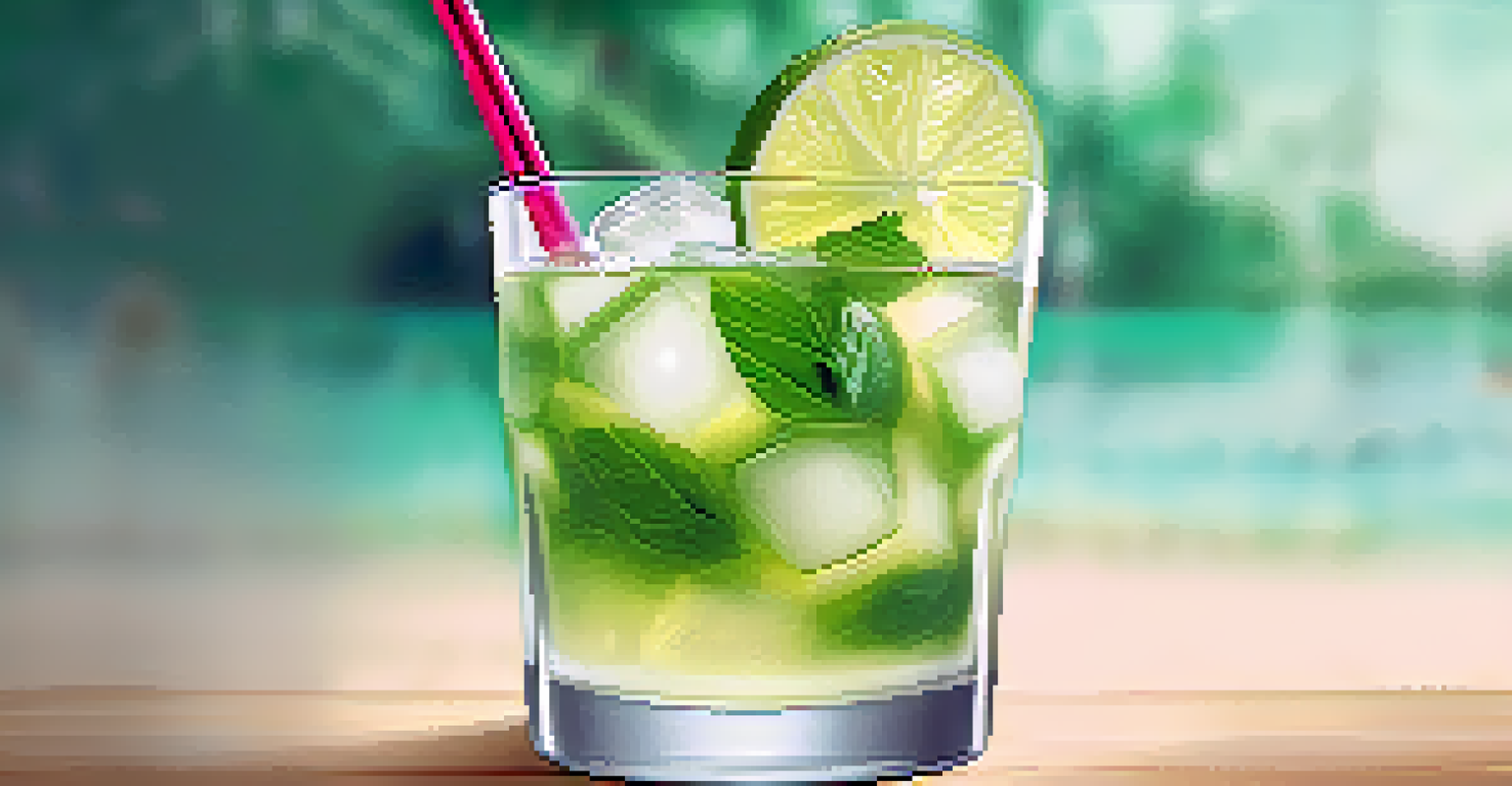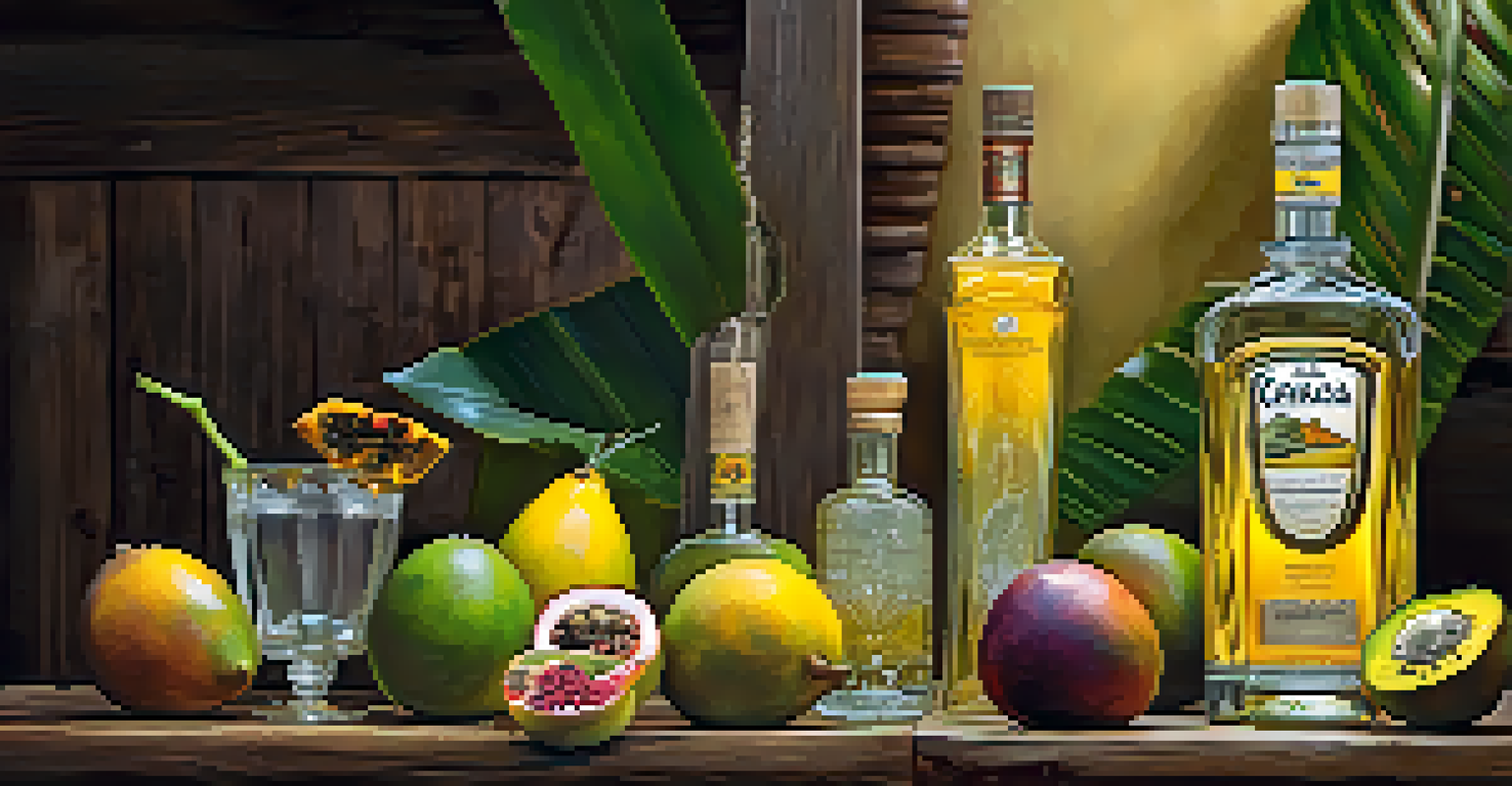Cachaça: Brazil's Iconic Spirit and Its Culinary Uses

The Rich History of Cachaça in Brazil
Cachaça has deep roots in Brazilian culture, dating back to the 16th century. It originated when Portuguese settlers began distilling sugarcane juice, leading to the creation of this unique spirit. Over the centuries, cachaça evolved, becoming a symbol of Brazilian identity and a crucial ingredient in many traditional drinks.
Cachaça is more than just a drink; it’s a celebration of our culture and craftsmanship.
The spirit gained prominence in the 19th century, especially with the rise of the famous caipirinha cocktail. This refreshing drink showcases the vibrant flavors of cachaça mixed with sugar and lime, making it a favorite among locals and tourists alike. Today, cachaça is not just a drink but a celebration of Brazil's rich heritage and craftsmanship.
Cachaça is often referred to as 'Brazil's national spirit', and its production is regulated by law, ensuring quality and authenticity. This spirit reflects the diverse regions of Brazil, with various styles and flavors influenced by local sugarcane varieties and unique production methods.
Understanding Cachaça: Types and Flavors
Cachaça comes in two main types: 'branca' (white) and 'dourada' (gold). Branca is typically unaged and has a clean, fresh taste, while dourada is aged in wooden barrels, giving it a richer flavor profile. This aging process can lead to hints of vanilla, caramel, and spices, making each sip a delightful experience.

The flavor of cachaça can vary significantly depending on the type of wood used for aging. For example, barrels made from Brazilian oak impart unique characteristics not found in other spirits. This variety allows cachaça to be versatile, appealing to different palates and culinary applications.
Cachaça: Brazil's National Spirit
Cachaça, originating from 16th century Brazil, has become a symbol of Brazilian identity and is essential in traditional drinks like the caipirinha.
Additionally, cachaça can be infused with fruits and herbs, such as passion fruit or mint, offering even more flavor options. These infusions not only enhance the taste but also make cachaça an exciting ingredient in cocktails and culinary dishes.
Cachaça vs. Rum: Key Differences Explained
While cachaça and rum may seem similar, they have distinct differences rooted in their production processes. Cachaça is made from fresh sugarcane juice, while rum is typically produced from molasses, a byproduct of sugar refining. This fundamental difference affects their flavor profiles and overall character.
The beauty of cachaça lies in its versatility, whether in cocktails or culinary creations.
The geographical origins also play a role; cachaça is exclusively produced in Brazil, whereas rum is made in various countries around the world. This regional specificity gives cachaça a unique identity, steeped in Brazilian culture and tradition, which rum might not convey.
Moreover, cachaça often has a more pronounced grassy or herbal note, while rum can lean towards sweetness and spice. Understanding these differences can help you appreciate each spirit's unique qualities, enhancing your tasting experience.
Cachaça in Cocktails: A World of Flavor
Cachaça is incredibly versatile and can elevate a variety of cocktails beyond the classic caipirinha. Mixologists love experimenting with cachaça, incorporating it into drinks like the 'batida', which blends cachaça with fruit juices and sweeteners for a tropical twist. The fresh flavors of cachaça complement fruits beautifully, creating refreshing concoctions.
Another popular cocktail is the 'cachaça mojito', where cachaça replaces rum, adding a unique twist to the traditional recipe. The result is a refreshing drink with a distinctive Brazilian flair, perfect for summer gatherings or casual get-togethers. This adaptability makes cachaça a favorite among cocktail enthusiasts.
Versatile Uses in Cocktails and Cuisine
Beyond cocktails, cachaça enhances culinary dishes, serving as a key ingredient in marinades, sauces, and even desserts.
For those looking to explore further, cachaça can also be used in sour cocktails, tiki drinks, and even in culinary applications like marinades. Its ability to pair with various ingredients opens up endless possibilities for creative cocktail crafting.
Culinary Uses of Cachaça: Beyond the Glass
Cachaça isn't just for drinking; it's a fantastic ingredient in the kitchen as well. Chefs often use it to add depth to marinades, especially for meats like chicken and pork. The spirit's acidity helps tenderize the meat while imparting a unique flavor that enhances the overall dish.
It's also a great addition to sauces and glazes, where it can bring a hint of sweetness and complexity. For example, a cachaça glaze can elevate roasted vegetables or seafood, offering a delightful balance of flavors. This versatility makes cachaça a beloved tool for culinary creativity.
Moreover, cachaça can be incorporated into desserts, such as cakes or sorbets, adding a tropical note that surprises and delights. The spirit's rich flavors can transform ordinary dishes into extraordinary culinary experiences, showcasing its potential beyond cocktails.
Pairing Cachaça with Food: Tips and Tricks
When it comes to pairing cachaça with food, think of it as you would wine or beer. The key is to match the spirit's flavor profile with the dish's ingredients. For instance, lighter cachaças pair wonderfully with fresh seafood or salads, while aged varieties complement richer meats or cheeses.
Spicy dishes, such as those found in Brazilian cuisine, can also be beautifully balanced with cachaça. The spirit's refreshing quality helps to cut through heat, making it an excellent choice for meals that pack a punch. Pairing cachaça with food can enhance both the dining and drinking experience.
Innovations Driving Cachaça's Future
As global interest in cachaça grows, producers are embracing new techniques and flavors, ensuring the spirit remains relevant and exciting.
Experimenting with different pairings can lead to delightful discoveries, so don't hesitate to try various combinations. Cachaça can surprise you with its compatibility across a range of cuisines, from classic Brazilian dishes to international fare.
The Future of Cachaça: Trends and Innovations
As the global appreciation for cachaça continues to grow, innovative producers are experimenting with new techniques and flavors. From organic and artisanal varieties to unique infusions, the cachaça market is evolving, offering something for everyone. This trend reflects a broader movement towards craft spirits and sustainable practices.
In addition to traditional methods, some distilleries are adopting modern technologies to enhance the production process while maintaining quality. These innovations help preserve the integrity of cachaça while appealing to a new generation of consumers eager to explore unique flavors.

The future of cachaça looks bright, with an increasing number of cocktail bars and restaurants featuring it on their menus. As more people discover this iconic Brazilian spirit, the possibilities for its culinary and mixology applications are virtually limitless.